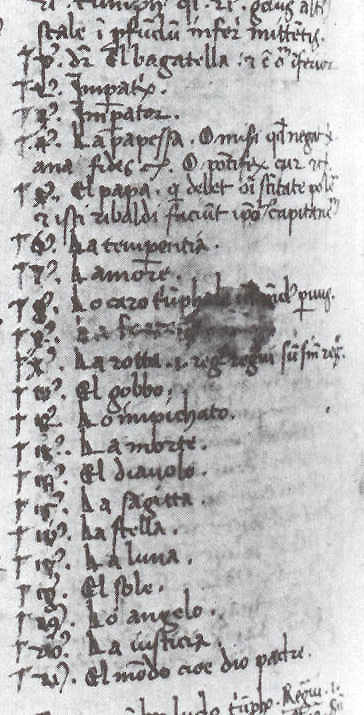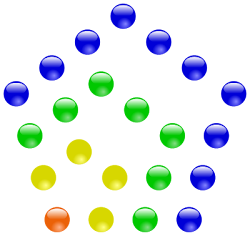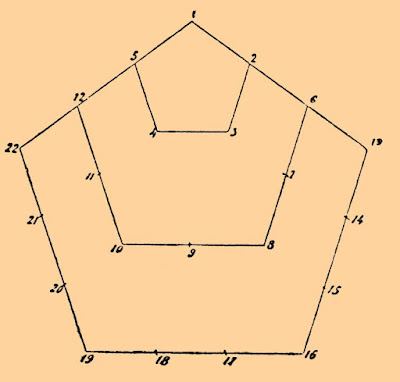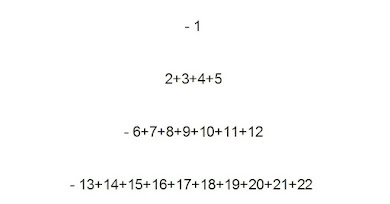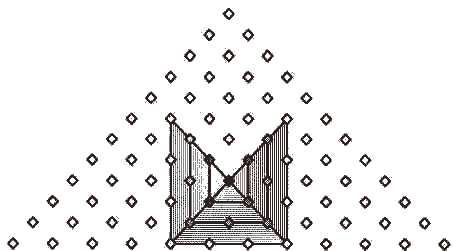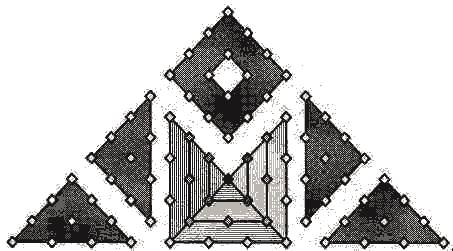Here is my translation of Alain's revised essay, based on his original at
https://docs.google.com/document/d/1s1L ... 16nKjI/pub, as of Sept. 4, 2016.
Perhaps in English it will be more conducive to discussion and critique on this forum than in French. I have asked his opinions on several matters of translation but he has not reviewed it before my placing it here. If there are place where you wonder if I have got it right, please let Alain or me know.
The arithmological sequence of the pentagonal number 22 = 1 + 4 + 7 + 10
Copyright Alain Bougearel, Member of the Scientific Committee of the Association “Le Tarot”,
http://letarot.it/page.aspx?id=35
Introduction: The mystical staircase of the 22 pictorial allegories
At one point in history, the number of cards finally settled at 78.
"The game of tarot is based on 56 cards called Italian, but actually of Arab origin (coins, cups, staves and swords), which arrived in Italy in the fourteenth century, and 22 cards as Triumphs introduced during the fifteenth century in Italy.
This game was probably inspired by Petrarch’s Triumphs...
The tarot sequence ... became, during the fifteenth century, 22 pictorial allegories of a new game. 22 is a number that in Christian mysticism signifies the importance of an introduction to the wisdom and divine teachings inculcated and imbued in men. These cards are a development that proclaims the evolution of 'playing cards' to religious requirements, perhaps to meet the wishes of the Church, which had regularly considered card games diabolical. Medieval theology assigns to the universe a precise order, consisting of a symbolic staircase that goes from earth to heaven: the top of the stairs, God, the First Cause, governs the world, without intervening directly but operating ex gradibus, that is, through a continuous series of intermediaries. Thus His divine power is transmitted to the lower creatures – even to the humblest beggar. On the other hand, if we read this symbology from the Depths to the Heights, we are taught that man can gradually rise in spiritual climbing the peaks of the bonum, verum and nobile, and that science and the virtues bring him closer to God."
(Andrea VITALI:
http://letarot.it/cgi-bin/pages/mostra_ ... r_sito.pdf)
I. The earliest literary source known: Anonymous, Sermones de ludo, circa 1500
"The first known list of tarot cards, that of the Sermones de ludo cum aliis, appears at the beginning of the sixteenth century, written by a preacher denouncing the game. However, the sequence conforms precisely to the ethical teachings of the Church.
http://www.tarotpedia.com/wiki/Sermones ... _Cum_Aliis
"The Bateleur [English "Magician", Italian "Bagatto", "Bagat" in 17th century French--trans.]
represents a a man who sins."
(Andrea Vitali, op. cit.)
He is guided by masters both temporal (Empress and Emperor) and spiritual, (Popess and Pope). He must overcome desire by practicing the virtue of Temperance and the thirst for power (Chariot) by the mistress of Strength. He learns the transitory character of human ambition (Wheel of Fortune).
(A. BOUGEAREL,
Origines et histoire du Tarot, p.21, Editions Envol, Toulouse, France, 1997)
"Thus the Hermit, who comes after the Wheel, represents Time, to which every being must submit, while the Hanged Man warns of the danger of giving in to temptation and sin before the arrival of physical Death.
"Even life after death is represented according to its appropriate design in the Middle Ages: Hell, and thus the Devil, are placed at the center of the earth, while the celestial spheres are above the earth. According to the Aristotelian vision of the cosmos, the terrestrial sphere is surrounded by 'celestial fires', represented in the Tarot by Lightning falling on a Tower. The planetary spheres are 'synthesized' into three main celestial bodies: Venus, the preeminent Star, the Moon and the Sun. The highest celestial body is the Empyrean, where the Angels sit that at the Judgment will be responsible for waking the Dead in their graves when divine Justice triumphs, weighing souls to separate the good from the bad. At the summit of all this arrangement is the World, namely God the Father, as wrote the anonymous monk who commented on the Tarot in the late fifteenth century. This same author places the Fool [Fou, Italian Folle or Matto, 17th century French Math--trans.]
after the World, as if to indicate that he is foreign to all the rules and all the lessons because, given his lack of reason, he is not able to understand the revealed truth. The thought of Scholasticism, which aimed to strengthen the truths of the faith through the use of reason, brings into the category of fools all those who do not believe in God.
Note: In the Tarot, the Fool's presence subsequently acquires a deeper meaning: the fool possessing reason but not being a believer, was to become, through the teachings expressed by the Mystical Staircase, the Fool of God, as Francis, the most popular saint, will become, named 'Holy Minstrel of God and Holy Fool of God'."
(Andrea Vitali, op. cit.)
II. The Pentagonal Number 22 and the 22 allegorical subjects
These 78 cards include 56 emblematic cards (40 numeral [10x4] + 16 courts [4x4]) and 22 allegorical subjects.
The Pythagorean arithmology of Nichomachus of Gerasa, like that of Iamblichus or of Theon of Smyrna (Cf.: Note 1), is one that mathematically defines triangular, square, and pentagonal numbers, teaching that:

(Cf:
https://www.loebclassics.com/view/pytha ... 335.99.xml)
10 is a Triangular number of base 4
16 is a Square number of base 4.
22 is a Pentagonal Number of base 4
Preliminary explications of the numbers depicted:
"The hexagonal, pentagonal, octagonal, etc., numbers give rise to similar diagrams. These tables are explained by the following observations:
1. Each number of the natural series is the side of the corresponding polygonal number.
2. Each series of polygonal numbers, begins with unity, which, according to an expression borrowed from Aristotle's Metaphysics, is triangular, square, pentagonal, etc., in power (δυνάμει), that is to say, potentially, while the following numbers of each series are triangular, square, pentagonal, etc., in act (ένεργεία), that is to say, actually. Each polygonal number of the same series contains the number of the previous polygon, plus the difference, and therefore each of these numbers is the sum of all the previous differences.
3. Thus, the differences are at the same time the numbers composing the polygonal numbers. The composing numbers or differences form the series whose first term is always unity, and in which each number is equal to the previous + 1 for the formation of numbers triangles, the previous + 2 for the formation of square numbers, the previous + 3 for the formation of pentagonal numbers, proceeding + m - 2 for the formation of numbers that have a number of sides m.
4. The polygonal number next to each polygon has as many units as there are component numbers included in the corresponding polygonal number. The names triangular, square, pentagonal, etc., given to these numbers can be explained by geometrical figures, where the units, represented by points, are distributed regularly, so as to show how each polygonal number of a series includes the number of the previous polygon plus the difference, and is the sum of all the preceding differences or component numbers."
(Th. Henri MARTIN, Dean of the Faculty of Arts of Rennes, France, Corresponding Member of the Academy of Sciences of Berlin, Germany. French translation of the Greek of the
Introduction to arithmetic of Nicomachus of Gerasa, Chapters IX and XX, Book II, with Notes by the translator, 1856, Rennes, France.
http://remacle.org/bloodwolf/erudits/ni ... etique.htm)
Series of polygonal numbers (which can be triangular, square or pentagonal)
"...
Natural series of numbers noted on the bottom side of the diagrams:
Triangular......................................1 2 3 4
Square..........................................1 2 3 4
Pentagonal...................................1 2 3 4
Series of component numbers or “differences” noted on the lower left and above each diagram
Triangular......................................1 2 3 4
Square..........................................1 3 5 7
Pentagonal...................................1 4 7 10
Series of polygonal numbers noted above each figure:
Triangular......................................1 3 6 10
Square..........................................1 2 9 16
Pentagonal...................................1 5 12 22
..."
(H. MARTIN, op. cit.)
Geometrical configuration of triangular, square, and pentagonal numbers:
"The manuscripts and editions of the Introduction to Arithmetic of Nicomachus lack these figures here; but they are found in the edition of the Commentary of Iamblichus and in both editions of the Arithmetic of Theon of Smyrna." (Th. Henri MARTIN, op. cit.)

The small lines connecting all the dots pertaining to each of the component numbers were superimposed by hand to figures that are arithmological in origin, i.e. diagrams of triangles, squares and pentagons - and to highlight these numbers, which, in being added, form each polygonal number.
Cf:
http://remacle.org/bloodwolf/erudits/ni ... etique.htm
The arithmological arrangement of the 22 allegorical subjects of the Tarot is that of the Pythagorean generation of the Pentagonal Number 22: 1 + 4 + 7 + 10 = 22.
(Cf.
https://fr.wikipedia.org/wiki/Nombre_pentagonal)
- Pentagonal Number 22 of order 4
Natural succession of the Numbers:
1 2 3 4
Series of the component numbers or “differences”:
1 + 4 + 7 + 10
Series of Pentagonal Numbers:
1 5 12 22
The points in the arithmological diagram have been replaced by small diamonds.
The lines were superimposed by hand in order to connect:
- The component numbers, in order to highlight them
The successive Four Enclosures of the component numbers together so as to emphasize visually their order of succession: first 1, then 4, then 7 and finally 10.
It is inserted into the overall arithmological layout of the 78:
 The 78 cards of the Tarot (1 + 2 + 3 + 4 + 5 + 6 + 7 + 8 + 9 + 10 + 11 + 12) are represented by diamonds arranged in an isosceles right triangle (Cf. note at bottom of page, at the end: definition and construction).
The 78 cards of the Tarot (1 + 2 + 3 + 4 + 5 + 6 + 7 + 8 + 9 + 10 + 11 + 12) are represented by diamonds arranged in an isosceles right triangle (Cf. note at bottom of page, at the end: definition and construction).
- 40 numerals [10x4]: 10 is a Triangular Number of base 4
- 16 figures [Court Cards--trans.] [4x4]): 16 is a Square Number of base 4.
- 22 allegorical subjects [1 = 4 = 7 = 10]: 22 is a Pentagonal Number of base 4.
The methodology requires that the Triumphs be arranged as if one ignored their iconography or ludic value, taking into account only their ordinal value i.e. from the first to the twenty-second position in the order of the generation of the Pentagonal number 22.
(Cf:
https://commons.wikimedia.org/wiki/File ... 53-0.jpg?u)
III. The problem of the Order of the Trumps [Fr. Atouts--trans.]
The problem of the Order of the Trumps [
Atouts] renders complex and delicate the replacement of the ordinal numbers of the Pentagonal Number 22 by the corresponding allegorical subject of the Triumphs.
I am indebted to Michael Hurst, in his "critical examination" of my theory of the sequence of Trumps 1 + 4 + 7 + 10 = 22, for drawing my attention to the work of Michael Dummett (
The Game of Tarot and the 1985 FMR article "Tarot Triumphant") and to the analysis of the
"Problem of the Order of the Trumps [Atouts]” by Thierry Depaulis in
Tarot Jeu et Magie:
"His analyses [those of Mr. Dummett], particularly that published in "The Game of Tarot" are not so different from the analysis you present here. (The differences are just your odd placement of the Fool; and your segregation of the Bateleur). Both of you divide the Triumphs at the Pope and Death, which gives a quite intelligible grouping of the series in three types of subject. The only "apparent" difference between your two analyses is that you focus on what is incidental, the number of images in each group, while Dummett fixed on what is essential, the type of subject in each group." (Michael Hurst, Ltarot, "Alain's 1 + 4 + 7 + 10 theory".) (Cf.: Note 2)
The four enclosures of the Pentagonal Number structure the 22 allegorical subjects of the Tarot into Four successive groups:
1 + 4 + 7 + 10 = 22
The ordinal progression is then:
1,5,12,22
First enclosure:
1
Second enclosure:
2,3,4,
5
Third Enclosure:
6,7.8;9,10,11;
12
Fourth Enclosure:
13,14,15,16;17,18,19,20,21;
22
What Mr. Hurst considers incidental, the Number, and as essential, the Image, is not important here - even if Hurst's belief in the primacy of Signified (Image) over Signifying (the Number) raises subjectivity over objectivity: how else to account for the sequence 22 when it comes to the poems of Boiardo or the 22 Figures of the Sola Busca?
Nothing prevents us from thinking that the final predominance of the structure of 78 cards, broken down into 22 Triumphs and 56 cards (4 × 10 + 4 × 4), belongs to so random a register of contingency - these numbers would then be purely incidental and random. Nonetheless, it will be understood, I do not share this opinion. Is it not important that the arithmology of the pentagonal Number 22 (quantitative aspect) coincides, not incidentally, with the symbolic and historical analysis of the allegorical series of Triumphs (qualitative aspect)?
In fact, the only difference between the sequence of pentagonal Number 22 as 1 + 4 + 7 + 10 and Dummett’s analysis into 3 groups is that one member of the whole constitutes a group of one by itself (The Bateleur [Magician] at Alpha) and the Fool is added to the end of the fourth group, in the last position, as twenty second in the sequence.
T. DEPAULIS for his part examines 12 different orders out of
"decks existing now", "old decks" and
"literary sources". He identifies a specific common progression of trumps, corresponding to the different orders, in 3 successive sequences, subject to excluding the virtues and the Fool. (Cf:
http://gallica.bnf.fr/ark:/12148/bpt6k6 ... /f24.image).
Sequence 1:
Bateleur, Pope/Popess, Empress/Emperor (with some variations)
Sequence 2:
Lover, Chariot, Wheel of Fortune, Hermit, Hanged Man (with some variations)
Sequence 3:
Death, Devil, Tower, Star, Moon, Sun, World, Judgment (with some inversions in the order for the last two)
The arithmological arrangement positions the 3 sequences in 4 enclosures:
Enclosure 1:
Bateleur
Enclosure 2:
Pope/Popess, Empress/Emperor (with some variations)
Enclosure 3:
Lover, Chariot, Wheel of Fortune, Hermit, Hanged Man (with some variations)
Enclosure 4:
Death, Devil, Tower, Star, Moon, Sun, World, Judgment (with some inversions in the order for the last two)
The analysis of the 12 orders leads to putting the orders of the sequence of Triumphs into 3 "blocs" (Cf. Note 3).
However, T. Depaulis's analysis of 1987 as presented in
Tarot, art and magic, exposition, BNF, has been, in 2013, updated and corrected by the author in
Le Tarot révélé: une histoire du tarot d’après les documents (
The Revealed Tarot: A History of the Tarot According to the Documents), 2013, ISBN 9782883750135.
Ordinal progression in 4 enclosures of the Pentagonal Number 22 specific to each of the 3 levels (not including the Math), being aware that the three virtues have different ordinal positions in each of the three types A, B and C (as described in Le Tarot Révélé, 2013, p. 25):
Type A, arranged in four enclosures:
T. Depaulis (op. cit.) gives some particular variations in Tarot enclosures 2 and 3 (according to whether that order is of Bologna or Florence).
1. Bateleur/
2. Empress/Emperor/Popess/Pope/ (with some variations)
3. Lover/Chariot/Temperance/Justice/Strength/Wheel of Fortune/Hermit/Hanged Man/ (with some variations)
4. Death, Devil, Tower, Star, Moon, Sun, World, Judgment
Remark:
The difficulty is that enclosure 3 has 8 tarot cards, not 7, while enclosure 4 has 8 or 9, not 10, even if the Fool was added, despite the lack of documentation on this subject.
Conclusion: Type A would not correspond to the sequence 1+4+7+10 = 22 with the Bagat as Alpha and the Fool as Omega.
TYPE B, arranged in 4 enclosures:
In this case Depaulis 2013 gives only one order.
1. Bateleur/
2. Empress/Empereur/Popess/Pope
3. Temperance/Amoureux/Chariot/Strength/Wheel of Fortune/Hermit/Hanged Man/
4. Death/Devil/Tower/Star/Moon/Soleil/Jugement/Justice/Monde
Remark:
Sermones de ludo, c. 1500. Note again that the
Sermones, of Order B, positions the Bagatella (Bateleur) in 1st position and places the Matto (Fool), while giving it the epiethet "nulla", on the twenty-second line, after the World, in the 21st position:
Conclusion: type B would correspond to the sequence 1+4+7+10 = 22 with the Bagat at Alpha and the Fool at Omega.
TYPE C, arranged in 4 enclosures:
In this case Depaulis 2013 gives inversions of the Empress and the High Priestess (in enclosure 2) and the same between the Hermit and Strength (in enclosure 3), (depending on whether the order C is of Italy (Pavia) or France.
Below, the Order of the so-called "Tarot de Marseille", France.
1. Bateleur/
2. Popesse/Empress/Emperor/Pope/
3. Lover/Chariot/Justice/Hermit/Wheel of Fortune/Hanged Man/
4. Death/Temperance/Devil/Tower/Moon/Sun/ Judgment/World
Remark:
The oldest
Rules of the Game of Tarot in France, transcribed by T. Depaulis (Cf. Note 4) and dated to 1637 * enumerate 22 Triumphs (Cf. Note 5):
This pack, which is composed of seventy-eight Cards, can be divided into five groups, the first and noblest of all called triumphs, which number twenty-two..." (Anonymous,
Les Règles du Jeu des Tarots - very probably written by the Abbé de Marolles at Nevers and published by Jean FOURRE at Nevers in 1637 - were inspired by Louise Marie de GONZAGUE-NEVERS **)
* 1637: lhttp://
www.tarock.info/depaulis.htm.
** Louise Marie de GONZAGUE NEVERS, “inspirer” of the Règles de 1637:
viewtopic.php?f=11&t=1102&p=17434#p17434
The Fool, analogous to a Triumph, would therefore be the twenty-second (the World, the 21st and the Bagat the 1st).
Enclosure 3 includes 7 tarots, and enclosure 4, 10 tarots.
Conclusion: type C could correspond to the séquence 1+4+7+10 = 22 with the Bagat at Alpha et the Math at Omega.
Conclusion: significance of the Math at the Omega of the arithmological sequence
The position of the Fool at Omega in the B and C orders after the World does not signify the Matto's triumph over the World but suggests the idea of a Madman falling perhaps into divine madness, even the playful and subversive theme of the medieval Festivals of Fools.
"The other side of the Mass of Fools in the Middle Ages is the wonderful innocence personified by the FOOL, who takes away the chaos. The 'crazy one', the village idiot, the most deprived, the youngest of the community - embodied and fixed in the TRUE CENTER, and it is through him that we hunt the scapegoat...
"The Mass of Fools takes place in the cathedral, ideal because its architecture meets all the medieval theological grandeur and life of the masses who have congregated to be elevated. Nevertheless we know from the work of Julio Caro Banoja that the Festivals of Fools quickly made the street: the people participating in these festivals were not the sole prerogative of cleric-insiders. Mass religious movements of in the Middle Age were mostly mobilized by disease, starvation or despair; they left little trace on institutions or medieval thought. Yet the shifting crowd in search of the supernatural and miraculous 'were immensely sure of themselves and contemptuous of traditional disciplines and restraints. In their zeal they swamped the ordinary organization of the church, broke through the barrier between the illiterate populace and the learned rulers of society, and spoke with certainty about things to come' (R. W. Southern, Western Society and the Church in the Middle Ages, p. 308). The Mass of Fools will also gather the creative energy of this people without writing."
Berry Hayward,
La Messe des Fous. [Translator's note: for the quotation from Southern, the English original was used rather than a translation of the somewhat loose French translation.]
Placed in a carnival perspective, the figure of the jester would affix itself to the festive triumphal processions of the second half of the fifteenth century.
"Is the jester not supposed to operate outside of the carnival procession, following it and moving about along the parade" like the Fool of the so-called Charles VI Tarot?
Copyright Alain Bougearel
NB:
For fuller information, consult the discussion of the thesis at:
viewtopic.php?f=11&t=1102
Selected Bibliography:
"The Order of the Triumphs, In ancient tarot cards and in 16th century documents"
By Andrea VITALI
Translation by Michael S. HOWARD
http://letarot.it/page.aspx?id=221
Nicomachus of Gerasa,
Introduction to Arithmetic, English translation by Martin Luther D’Ooge,
with
Studies in Greek Arithmetic, by Fank Egleston Robbins and Louis Charles Karpinski,
London: Macmillan and Company, Ltd., 1916.
https://ia600709.us.archive.org/27/item ... hmetic.pdf
"The astral origin of the Soul, A Neoplatonic myth in the iconography of a few cards of the Triumphs"
By Andrea VITALI:
http://letarot.it/page.aspx?id=197&lng=ENG
"The Astral Journey of the Soul, Porphyry and Plutarch in the context of the medieval cosmograph"
By Michael S. HOWARD:
http://letarot.it/page.aspx?id=454&lng=ENG
Notes:
(1) The examination of the Tarot (...) can only emphasize its close relationship with the philosophical current of the syncretism of the Florentine Renaissance, where the idea is elaborated that Platonic revelation would bring definitive truth.
....
Platonic Syncretism is massively enriched by contributions from Byzantine philosophers (a) fleeing Constantinople just before it was finally taken in 1453 by the Ottoman Turks led by Mehmed II the Conqueror.
Indeed, in the years 1438-1439, the Congress of Ferrara-Florence sees the growing exchange between Byzantine and Latin intellectuals.
"... The contacts between Greeks and Latins are growing (...) Many scholars and Byzantine scholars emigrated to the West early in the 15th century and foremost to Italy, where Congress of Florence was an exceptional meeting point.
'[They] carried with them many manuscripts, the majority of ancient works ... the contributions permitted the undertaking of the rediscovery of Antiquity "
(A. DUCELLIER,
Les Byzantins)
- (a) Thus, among the most famous:
* Jean Argyrotopoulos, co-founder of the Academy of Constantinople who removes himself to Italy in 1434 and teaches in Florence
* Gemistus Pletho, who journeys there in 1440, whose theses close to absolute Platonism inspired humanist Marsilio Ficino, founder of the Platonic Academy.
(2) However, the 'critical' analysis of Mr Hurst does not subsequently prevent his recognition of interest to arithmological vision of the Tarot:
Michael Hurst:
"I recommend Alain Bougearel's 78-card analysis as PARTICULARLY attractive, conceptually neat, generally charming, and quite devoid of explanatory value." (Tarot History Forum)
(3) "Michael Dummett has shown that in Italy, the cradle of the tarot, the early years of the spread of the game from one center, three "branches" or "schools" were formed, characterized by slightly different orders of trumps [atouts].
One of these "schools" can be located in Florence (and Bologna), the other in Ferrara, the third in Milan. Dummett named them "orders" A, B and C.
Order A is found in Florence (Minchiate) and Bologna (where it is still played) and spread to the South, to Sicily (the Sicilian tarot still bears traces of it).
Order B seems to be limited the north, starting from Ferrara: it is found in Venice and Trent.
Order C seems to be centered on Milan and the Milanese. It is to it that the "Marseille" Tarot is related.
The latter is therefore a branch of the three (or four, there is a branch "Savoy" branch, a hybrid of A and C, which survived for a long time in Savoy and Piedmont, united in one country until 1860).
Again in France, we cannot ignore the tradition of the "Belgian"Tarot (also called "Rouen/Brussels"), which disappeared in the eighteenth century without leaving much of a trace. Iconographically, it is very different from that of the Tarot of Marseille. Its movement remains mysterious."
(T. DEPAULIS,
Les Tarots et leur histoire, 2013,
https://legrimoiredemnemosyne.wordpress ... r-histoire
(4) This dating is included in "Lois et règles de jeux pour l’esprit et le bonheur des hommes" [Statutes and rules of games for the mind and the happiness of mankind] by Manfred Zollinger:
http://expositions.bnf.fr/jeux/arret/03_3.htm
Transcription from the original, kept in the Bibliothèque Nationale de France, by Thierry DEPAULIS of
Règles du Jeu des Tarots.
The book is printed in Nevers, France in 1637.
The author is anonymous; however T. DEPAULIS ascribes authorship to the Abbot de Marolles.
The "Rules of the game of Tarot" were "inspired" by the Princess Marie Louise Gonzaga-Nevers, daughter of the Duke of Mantua during the stay of Michel de Marolles in Nevers who wrote them during the summer 1637 and gave them to Jean FOURRE who edited the Nevers in the same year.
(Episode related by T. DEPAULIS in the Introduction to
"Quand l’abbé de Marolles jouait au Tarot", Le Vieux Papier, July 2002:
http://www.academia.edu/15316947/_Quand ... p._313-326
Cf.
Le jeu des tarots, 1637, pp.209-214:
Mémoires de Michel de Marolles, Abbé de Villeloin, avec des notes historIques et critiques; printed in Amsterdam, 1755).
https://books.google.de/books?id=zJoPAA ... ts&f=false
T. DEPAULIS (op. cit.) corrects la Notice thus:
[MAROLLES, Michel de], Regles dv iev des tarots, s.l. [Nevers]: s.n. [Jean Fourré], s.d. [1637]
(BnF, Mss., Dupuy 777, f° 94-97.)
Nonetheless, it will be noted that from 1585, in the
Triomphe du Berlan by PERRACHE, specific expressions are already textually present later literally reproduced identically in The Regles dv iev des tarots de l’abbé de Marolles (1637), said of 1637.
"Thus three publications of the 1580s use terms that are in full conformity with the Regles dv iev des tarots of the abbé de Marolles (1637). Besides the basic vocabulary - mat, bagat, derniers, bâtons, triomphes, écart - which is already current in French, expressions or situations are encountered that are fully consistent with what a slightly later text teaches us. The accounts of Henry of Navarre confirm the choice of a game for three.
"We are therefore entitled to think that very similar practices - three players without bidding, discard made by the dealer, importance of combinations (four kings, seven tarots), Fool serving as excuse, high value (5 points) granted to kings, counting points with a limit at 20 – took place during at least in the last quarter of the sixteenth century, if not sooner. Henry of Navarre is a Béarnais, his partners are Gascon, Charentais or Champagnois; Tabourot is Burgundian, Perrache is Provencal, Gauchet is Île de France, these three issue their books in Paris: there is every reason to believe that these rules were known in a good part of the kingdom."
(
http://www.academia.edu/15317283/_%C3%8 ... p._386-392)
(5) In the Rules of 1637 (probably in use in the last quarter of the 16th century: see Note 4), the Fool is necessarily made part of the 22 Triumphs:
"(...) la première & la plus noble de toutes appellée triomphes qui sont au nombre de vingt-deux (...)
[(...) The first and noblest of all called triumphs, which are in number twenty-two (...)]"
It is systematically cited after the World and before the Bagat:
"La beauté de ce jeu est d'auoir force triomphes & principallement les hautes auec le Monde, le Math, & le Bagat, & quelques Roys: par ce qu'auec les triomphes on surmonte tous les efforts des quatres [sic] peintures, quand on y fait des renonces. Et par le moyen du Monde, Math, & Bagat, & les Roys, on se fait payer autant de marques de chacun que lon en peut leuer en joüant, à cause de quoy on les nomme Tarots par excellence. Et toutes les fois qu'ils paroissent dans le jeu, il leur faut payer le tribut ou eux mesmes sont contraints de payer la rençon s'ils tombent entre les mains de leurs ennemis, c'est à dire que celuy qui les perd donne vne marque à chacun."
"Et d'autant que la valeur des cartes est aussi considerée lors qu'il faut desconter a la fin du coup, il est necessaire de sçauoir que chacun des sept Tarots vaut cinq points, s'il est joinct auec deux autres cartes de nulle valeur. Les Roynes valent quatre: les Cheualiers trois, & les Faons deux, se trouuans pareillement chacuns accompagnez de deux cartes sans prix. Et vne main toute simple vaut vn point.
"Or afin de ne perdre aucune de ces cartes à la fin du coup, il est requis que chacun des trois pesonnes qui joüent aye vingt-cing [sic] de ces points dans son jeu: car s'il en perd cinq il payera vne marque à celuy qui les gaignera: S'il en perd dix, il payera deux marques, & s'il en perd quinze, il payera trois marques: mais s'il n'en perd que trois ou quatre il ne payera rien: & tout de mesme s'il n'en perd que sept, huict, ou neuf, il ne payera qu'vne marque: & dans ce descompte les triomphes, excepté le Monde, le Math, & Bagat, sont de nulle valeur pour les points que i'ay dits.(...)
[Translator's note: for a translation, with notes, of the first paragraph, see
http://www.trionfi.com/0/p/1637.html.]
The Math serving as Excuse is considered as being part of the 7 Tarots:
" ...Monde, Math, & Bagat, & les Roys"
(...) "excuse se faict auec la carte du Math, qui est vn des sept Tarots, qui ne prend point & ne peut estre pris"
["World, Math, & Bagat, and the Kings"
(...) "excuse is made with the card of the Math, which is one of the seven Tarots, which cannot take anything and cannot be taken"]
The Math is part of the Highs [
Hautes]:
"(...) les hautes auec le Monde, le Math, & le Bagat
(...) trois Tarots, Monde, Math, & Bagat"
["(...) the highs with the World, Math, & the Bagat
(...) three Tarots, World, Math, & Bagat"
(T. DEPAULIS,
Les Règles du Jeu des Tarots, 1634:
http://www.tarock.info/depaulis.htm)
Comment:
Why was the Math specifically named as one of the triumphs, in bringing their number to 22, and cited after the World and before the Bagat among the Highs - while retaining its specific function of Excuse?
Math serving as an excuse is described as
"not taking and not being taken".
In subsequent rules there will be listed 21 Trumps [
Atouts] + the Excuse.
The contradiction is only apparent, if one takes into account the following hypothesis:
- of a reminiscence of the old value of the Matto to which is awarded the epithet "nulla" in the B Order, circa 1500, where it is positioned on a twenty-second line, after the World and before the Bagat.
- that the ultimate strategy of the game was to score the most points and if possible all of them - which will be the case for the player who has the Excuse in his hand, if he plays it at last trick as in the case of the Slam [
Chelem].
Thus the Math, if it cannot take and cannot be taken, however, then takes away the last trick.
One can rationally infer that this particular function of the Math, serving as Excuse, winning the last trick (and therefore all the tricks as in case of the Slam [
Chelem] was possibly in use in 1637 or before (1580) - although in the current state of historical research, the documents are missing.
For example, we now know that playing tarot was a "family tradition" of Henry of Navarre. (
http://www.academia.edu/15317283/_%C3%8 ... p._386-392).
It is almost impossible that in the course of all these hands played the opportunity will not present itself for a player with the excuse in his hand to win all the tricks.
The only way to achieve what is later called the Slam [
Chelem] is to play the Excuse as the last trick after
le Petit [the Little One, i.e. the Bagat--trans.] in the next to last trick.
That the drafters of the Rules did not note this ultra-winning strategy does not prevent, in my opinion, empirical knowledge of this specification by serious players ...
In addition, knowing that players’ practice always precedes published rules and that these are published circa 1580 throughout France, the probability is reduced to zero, for at least one player, considering the number of hands played and number of players in the kingdom, for not winning all the tricks with the Excuse in his hand
The
rarity of what will be subsequently called the Slam [
Chelem] (nomenclature of our time, with mandatory announcement) therefore does not invalidate in any case the
multiplicity of hands with the Fool acting as Excuse winning the last trick as a Triumph (and what is even more beautiful: all the tricks then being won) – taking into account, in France at the time, the large number of players and therefore the high number of hands played.
_____________
Definition:
An isosceles right triangle, also called right isosceles, has a right angle with two adjacent sides of the same length, with, therefore, two 45° angles at the base.
Geometric construction of a triangular number from a square cut diagonally:
Geometric construction of the triangular number of base 12 = 78.
The geometric production of triangular numbers is made from a square cut diagonally.
The geometrical production of the triangular number of base 12 (1 + 2 + 3 + 4 + 5 + 6 + 7 + 8 + 9 + 10 + 11 + 12 = 78) is obtained from a square of base 12: [12 squared = 144], cut diagonally.
Then the diagonal divides the initial square into two unequal triangular numbers: 78, of base 12, and 66, of base 11 - [78 + 66 = 144].
The larger of the two is that of the triangular number 78 of base 12.
(Thanks to Jean Michel DAVID for these clarifications:
http://www.tarotforum.net/showthread.php?t=29707&page=4)
[Translator's note: I have written an addition to Alain's essay at
http://tarotarithmologique.blogspot.com/.]

